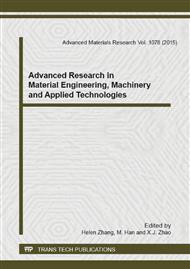p.82
p.86
p.90
p.94
p.98
p.102
p.106
p.110
p.114
Synthesis and Properties of 1-(2-Methyl-3-benzothiophene)-2-[2-methyl-5-(3-fluoro-4-chloro)phenyl-3-thienyl]perfluorocyclopentene
Abstract:
An asymmetrical photochromic diarylethene1-(2-Methyl-3-benzothiophene)-2-[2-methyl-5-(3-fluoro-4-chloro) phenyl-3-thienyl] perfluorocyclopentene (1o) was synthesized and its phtochromic, fluorescent properties were investigated in detail. This compound exhibited remarkable photochromism, upon irradiation with 297 nm UV light, the colorless solution of 1o turned to violetred with a new visible absorption band centered at 538 nm (ε = 1.17 × 104 L mol-1 cm-1) attributable to the closed-ring isomer 1c. The kinetic experiments showed that the cyclization and cycloreversion processes were zeroth and first order reaction, respectively. Moreover, diarylethene 1o also exhibited obviously fluorescence switches along with the photochromism.The emission intensity of diarylethene 1o in a photostationary state was quenched to ca. 27% in hexane.
Info:
Periodical:
Pages:
98-101
Citation:
Online since:
December 2014
Authors:
Keywords:
Price:
Сopyright:
© 2015 Trans Tech Publications Ltd. All Rights Reserved
Share:
Citation:


